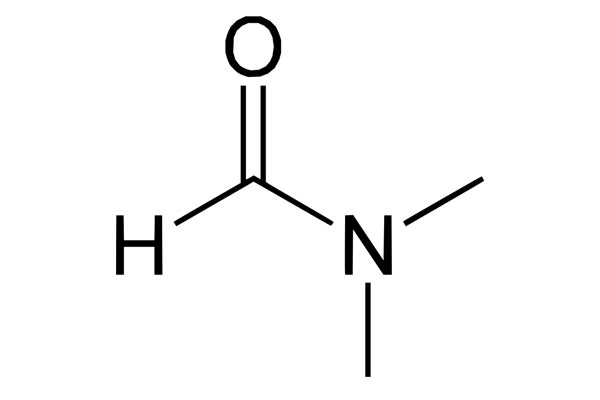Cas No: 68-12-2
EINESC No: 200-679-5
Molecular weight: 73.095 g/mol
Chemical Formula: C3H7NO
Chemical Structure:
Physical Properties
General Properties: Colorless liquid
Odor: Odorless
Intensity: 0.948 g/cm3
Boiling point: 153 °C
Melting point: -78 °C
Flash point: 58 ° C
Vapor pressure: 516 Pa
Refraction index: 1,4305 nD (20 ° C’de)
Solubility (aquenous) miscible in every amount

General Properties
Dimethylformamide, or DMF, is a colorless liquid that can easily be mixed with many organic solvents and water. It is normally odorless however, it gains a disturbing fish-like odor due to impurities.
DMF, as the name implies, is a variant of formamide, amide and formic acid. It is a polar, aprotic solvent that has a high boiling point. It eases polar mechanism based reactions such as SN2 reaction.
Production
DMF is industrially acquired from combining methyl formate and dimethylamine or reaction of dimethylamine and carbon monoxide.
Applications
DMF is used as a solvent that has low ratio of evaporation in acrylic fibre and plastic production. DMF’s main advantage in this area is its ability to dissolve solid in high amounts. Therefore, it is more economic compared to many other solvents.
DMF is also used in pesticide production. It is preferred in synthetic leather, glue and surface coating films.
DMF is commonly used in dye and dye remover productions. It is used as byproduct and catalyst in many industrial reactions.
Safety Measures and Toxic Values
DMF is a flammable chemical and it can yield exothermic reactions by itelf. Therefore, it must be kept away from direct fire.
DMF is also toxic for humans. It is extremely irritant for skin and eyes. It is easily absorbed through skin and it may cause serious damage to liver. It may cause stomach ache, constipation, nausea and vomiting, head ache, weakness, vertigo, skin problems and alcohol intolerance.